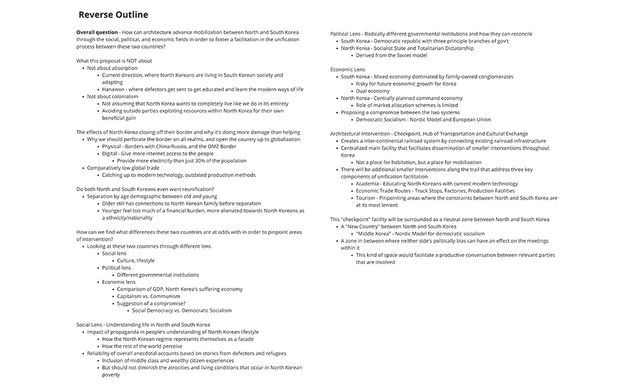[10/30] Thesis Proposal - Reverse Outline [1/3]

Overall Question
This proposal question has taken on many forms over the course of this past summer into this point in the semester. When summer started, my problem statement was:
”How can I use blockchain technology (digital) to empower newly built fabric (physical) along the DMZ border and accelerate the assimilation of North Koreans in a reunified society?”
This was the initial phase when I was speculating what kind of project I should do when addressing the Korean Reunification. This was the time where I believed that facilitating the assimilation of North Koreans into modern day society was a beneficial change to their lifestyle, without having much consideration to their mental state of being conditioned to being devout for their leader.
In preparation for the fall semester, my thesis proposal was divided into three categories:
- With the recent development of peace talks between North Korea and South Korea, why are the circumstances of their divide important to understand?
- How can these border conditions be addressed as an architectural problem?
- How can we leverage the advantages of blockchain technology to begin to shape spaces and interactions between people and communities, as well as understand the system of distribution and its impact on housing and public spaces?
This proposal attempts to separate the integral parts of my thesis proposal into digestible categories when explaining each segment to the audience, whether they’re fairly new to the subject of the historical context of the Korean War, how they were divided, the idea of architectural development behind it, and the involvement of blockchain in the whole process.
Currently, my problem statement speculates:
”How can architecture advance mobilization between North and South Korea through the social, political, and economic fields in order to foster a facilitation in the unification process between these two countries?”
What this proposal is NOT about
This section is dedicated to making it clear what this proposal is not about.
NOT about absorption
In the direction that the current events are going, it seems that North Korea is going to be absorbed by South Korea, and that is going to be a huge financial burden to South Korea on its own.

source
This is seen with current North Korean defectors and refugees that are mostly living in South Korea. The educational facility Hanawon is where current defectors are sent to be educated and adjust into South Korean society.
NOT about Colonialism
This is not assuming that North Korea wants to completely live like we do in its entirety. There is also the consideration for avoiding outside parties exploiting resources within North Korea for their own beneficial gain. They should be looked at as equals, rather than a subject of exploitation.

source
NOT about Cultural Homogenization
This space in between North and South Korea should be a space that allows for difference rather trying to create a single homogenous being in one Korea once reunification is achieved.

source
Modernity is vernacular globalization, where it is less as a concession to large-scale national and international policies. We should understand that history has taken its course on establishing the differences between North and South Korea, and they shouldn’t be homogenized completely for a successful reunification process.
The effects of North Korea closing off their border
North Korea being the most closed off country in the world is doing more damage than helping. The country should perforate their borders on both realms, and open the country up for globalization.

source
On the physical realm, the borders with China and Russia, along with the DMZ should be opened for inter-continental economic trade and travel. On the digital realm, they currently have very limited access to internet, or even electricity, with roughly 30% of their population having electricity, and less than 1% having access to the internet.
They also have comparatively love global trade because they are so closed off. This may explain their disastrously low GDP per capita in comparison to South Korea’s economic growth. They both were in tatters after the Korean War, with North Korea having more of the natural resources, but the centrally planned economy has not been working out for them ever since.

Congratulations @twotoedsloth! You have completed the following achievement on the Steem blockchain and have been rewarded with new badge(s) :
Click here to view your Board of Honor
If you no longer want to receive notifications, reply to this comment with the word
STOPDo not miss the last post from @steemitboard: